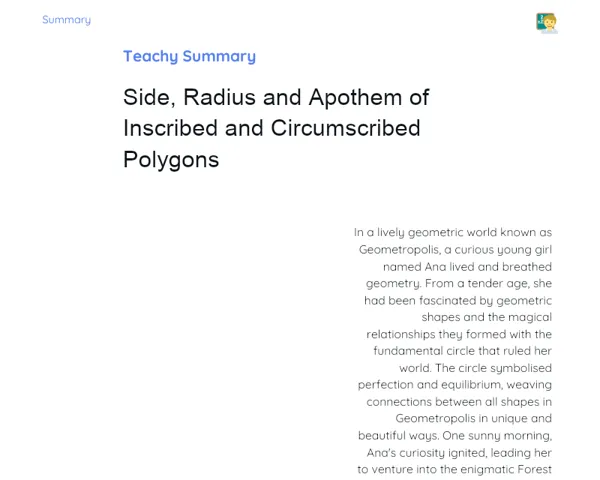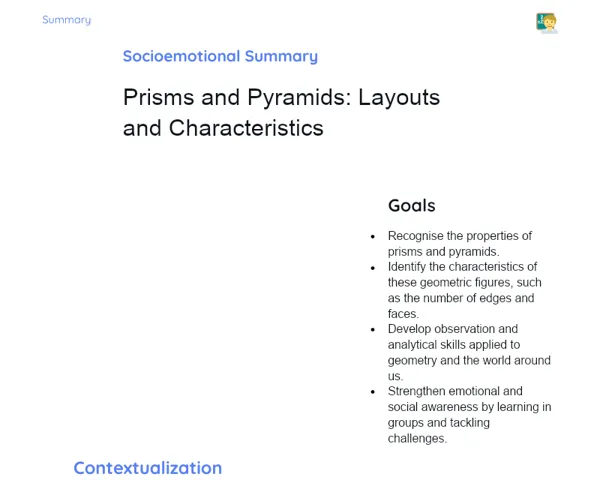Summary Tradisional | Circle: Inscribed and Central Angles
Contextualization
A circle is one of the cornerstones of geometry, commonly encountered in our math classes. It’s essentially a set of points that are all the same distance from a specific point, known as the centre. When studying circles, two key types of angles come into play: inscribed angles and central angles. These angles are vital for grasping various geometric concepts and interrelationships.
Inscribed angles are formed with their vertex on the circumference of the circle and their sides as chords of that circle. Central angles, in contrast, have their vertex at the centre and their sides as radii. One of the most fascinating properties in circle geometry is that the inscribed angle is always half the size of the central angle that subtends the same arc. This principle finds application in fields like physics—such as in describing planetary orbits—as well as engineering, especially in designing circular structures.
To Remember!
Definition of Inscribed Angle
An inscribed angle is defined as the angle with its vertex on the circle's circumference, while its sides are chords of the circle. This means that the two line segments forming the angle intersect the circle at two distinct points. A notable feature of inscribed angles is that they are reliant on the circumference for their existence and cannot exist outside of it.
One intriguing property of inscribed angles is that any inscribed angles subtending the same arc are equal. In simpler terms, if you have two inscribed angles that open up to the same arc, they will measure the same. You can visualise this by sketching various angles in the circle that intercept the same arc; they will all share the same measure.
Additionally, an inscribed angle that subtends a semicircle (an arc measuring 180 degrees) is always a right angle, measuring 90 degrees. This results directly from the relationship between the corresponding central angle—which would be 180 degrees—and since half of 180 is 90.
-
The vertex of the inscribed angle lies on the circumference.
-
The sides of the inscribed angle are chords of the circle.
-
Inscribed angles subtending the same arc are equal.
-
Inscribed angles subtending a semicircle are right angles (90 degrees).
Definition of Central Angle
A central angle is one where the vertex is located at the centre of the circle, and its sides extend along the radii of the circle. Unlike inscribed angles, the central angle is characterised by having its vertex positioned at the centre, and it’s defined by the lengths of the radii that create the angle. Central angles are key in understanding many properties of circles.
A crucial aspect of central angles is that they dictate the length of the arcs they cut across. For instance, if a central angle measures 60 degrees, it will intercept an arc of 60 degrees on the circumference. This clear link between the central angle and the arc involved is what makes central angles so important in circle geometry.
Furthermore, you can use the size of a central angle to find the measure of the inscribed angle corresponding to it. As previously mentioned, the inscribed angle is always half the size of the central angle that intercepts the same arc. This proves incredibly useful for tackling geometric problems and measuring components within the circle.
-
The vertex of the central angle is located at the centre of the circle.
-
The sides of the central angle are the radii of the circle.
-
The size of the central angle determines the arc it cuts across.
-
The inscribed angle corresponding to a central angle is always half its measure.
Relationship Between Inscribed Angle and Central Angle
The relationship between inscribed and central angles is a key aspect of circle geometry. Essentially, the inscribed angle is always half the size of the central angle that subtends the same arc. To visualise this relationship, you’d draw a central angle alongside its corresponding inscribed angle over the same arc of the circle.
For example, if you consider a circle with a central angle of 120 degrees, the corresponding inscribed angle that intercepts the same arc would measure 60 degrees, which is half of 120 degrees. This relationship holds true universally for any inscribed angle and its related central angle.
Understanding this relationship is invaluable not only for solving geometric mysteries but also has practical implications in areas like engineering and physics. For instance, when designing wheels or gears, the connection between inscribed and central angles ensures that parts mesh correctly and perform as intended.
-
The inscribed angle measures half of the corresponding central angle.
-
This relationship is consistent and applies to all inscribed and central angles.
-
The relationship is crucial for both solving geometry problems and practical applications.
Relationship Between Inscribed Angles and Arcs
The interplay between inscribed angles and arcs is another captivating property in circle geometry. Inscribed angles that focus on the same arc are equal, which means that even if their vertices are situated at different points along the circumference, as long as they open to the same arc, they will boast the same measure.
Moreover, when an inscribed angle cuts across an arc of 180 degrees (resulting in a semicircle), it will invariably be a right angle measuring 90 degrees. This is due to the fact that the corresponding central angle for a semicircle is 180 degrees, and half of that is 90 degrees, which is the inscribed angle's measure.
This property has practical implications, especially in the design and construction of circular objects. Knowing that inscribed angles cutting across the same arc are equal helps ensure that designs are both symmetrical and accurate.
-
Inscribed angles subtending the same arc are equal.
-
Inscribed angles cutting across an arc of 180 degrees are right angles (90 degrees).
-
This property assists in creating symmetrical and precise designs.
Key Terms
-
Inscribed Angle: An angle with its vertex on the circle's circumference and sides as chords of the circle.
-
Central Angle: An angle with its vertex at the centre of the circle and sides as radii of the circle.
-
Arc: A section of the circle's circumference defined by two points.
-
Semicircle: An arc that represents half of the circle's circumference.
-
Chord: A line segment connecting two points on the circle’s circumference.
-
Radius: A line segment stretching from the centre of the circle to a point on the circumference.
Important Conclusions
In this lesson, we delved into the definitions and properties of inscribed and central angles within circles. We discovered that an inscribed angle has its vertex on the circle's circumference, while a central angle features its vertex at the centre of the circle. One of the most significant relationships discussed is that the inscribed angle is consistently half the size of the corresponding central angle, which is essential for tackling geometric challenges.
Additionally, we observed that inscribed angles subtending the same arc are identical, and inscribed angles in a semicircle are always right angles (90 degrees). These properties are not just theoretical; they find applicability in various areas like engineering and design. Grasping these concepts empowers us to solve numerous problems and design precise, symmetrical structures.
Lastly, we underscored the importance of continually exploring these concepts to deepen our understanding and improve our ability to apply them in diverse contexts. The mathematics surrounding circles is abundant in applications and underpins further studies in geometry and other scientific fields.
Study Tips
-
Go over the examples and diagrams shared in class—try sketching your own circles and angles to solidify your understanding of the relationships covered.
-
Practice solving more problems that involve identifying and calculating inscribed and central angles using textbooks or online resources.
-
Consider forming study groups with your classmates to discuss the properties of inscribed and central angles; supporting each other can clarify doubts and reinforce knowledge.



